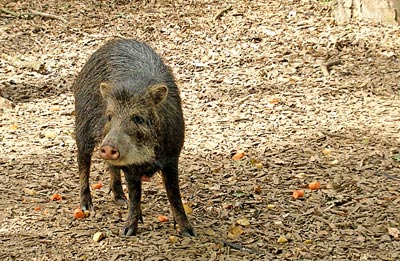Peccaries are often referred to as wild pigs. Indeed, the local name for the white-lipped peccary in Costa Rica is chancho de monte. However, they are not true pigs. The similarity between true pigs and peccaries is an example of convergent evolution, resulting from the fact that they both evolved independently to occupy similar ecological niches - omnivorous rooters. True pigs (family Suidae) - which include the wart hog of Africa, the babirusa of Sulawasi, the wild boar of Eurasia (from which the domestic pig is derived), among others - evolved in the Old World along parallel lines to the Peccaries, (family Tayassuidae), in the New World. An obvious difference between the two families is that in true pigs (especially pronounced in males), the upper canine teeth grow outwards and upwards forming clearly visible tusks. The upper canines of peccaries grow downwards and are not visible from the outside when their mouths are closed. In both families, the enlarged canine teeth represent formidable weapons. (Osa Safari: The White-Lipped Peccary, by Mike Boston of Osa Aventura).
